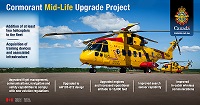Cormorant Mid-Life Upgrade
Project summary
The CH-149 Cormorant fleet has been providing reliable and crucial service to Canada since 2001 and requires upgrades to remain operationally effective. Through the contract with Leonardo U.K. Ltd., we will upgrade our current fleet to the most advanced version of the helicopter, and acquire additional airframes/parts to increase our fleet size from 13 to 16 aircraft. This will ensure that we can continue to perform search and rescue operations from Comox, B.C., Gander, N.L., Greenwood, N.S., and add to the search and rescue capacity from Trenton, Ont.
Moreover, this project addresses the need for an improved training solution. By contracting CAE to provide a domestic flight simulator configured to our modernized aircraft, our aircrews will have dedicated training capacity in Canada and will no longer need to travel to the United Kingdom to train.
This project will extend the estimated life expectancy of the CH-149 Cormorant to at least 2042, address obsolescence issues, and ensure compliance with emerging regulations.
Project phases

Currently in Phase 4: Implementation
1. Identification
1. Identification
n/a
2. Options analysis
2. Options analysis
n/a
3. Definition
3. Definition
- Project approval: February 7, 2019
4. Implementation
4. Implementation
- Project approval: November 2022
- Contract award: December 2022
- First delivery: 2027
- Initial operational capability: 2027
- Final delivery: 2029
- Full operational capability: 2030
5. Close-out
5. Close-out
- 2030
Learn more about the Defence procurement process
Additional information
Project updates
Project updates
October 2025
Three AW101-615 variant airframes are in various stages of production at the Leonardo facility in Yeovil, U.K.
September 29, 2025
Production of the remaining CH-149 Cormorant airframes began at IMP Aerospace & Defence’s facilities in Halifax, N.S.
August 5, 2024
Launch of production of the first AW101-615 variant airframe at Leonardo Helicopters facility in Yeovil, United Kingdom.
December 22, 2022
CAE Implementation contract awarded.
December 22, 2022
Leonardo Implementation contract awarded.
September 25, 2018
The project briefing to the independent review panel was completed.
July 26, 2018
Project Option 3, upgrade of the CH-149 and augmentation with the use of VH-71 parts where possible, was approved.
May 2018
Canada released a Letter of Notification indicating the Government's intention to sole source the project with Leonardo.
January 2018
The AW-101 is endorsed as the only solution and the procurement strategy is approved.
September 2013
The Defence Capabilities Board approved the start of the Options Analysis phase.
July 2012
The Cormorant Mid-Life Upgrade project was initiated by the Commander of the RCAF.
Industry
Benefiting Canadian industry
Industry engagement so far includes:
- Leonardo provided an unsolicited proposal to upgrade Cormorants and augment fleet with conversion of 7 VH-71 helicopters to the search and rescue role in April 2013.
- A market survey was conducted through informal meetings and discussions held with over 25 companies interested in supporting the Cormorant Mid-Life Upgrade Project between 2016 and 2018. Discussions were held from staff to assistant deputy-minister levels in multiple government departments.
- Leonardo provided an updated unsolicited proposal to upgrade Cormorants and convert VH-71s in December 2016.
- Canada released a Letter of Notification indicating the Government's intent to sole source the Cormorant Mid-Life Upgrade Project to Leonardo in May 2018.
- Canada provided written responses to companies who have had concerns or questions with the procurement strategy in June 2018.
- Leonardo, with Innovation, Science and Economic Development present, held an industry day during the Farnborough airshow in July 2018.
Technical Requirements
Technical Requirements
The current in-service support contract is with IMP Aerospace. Competition for future sustainment will be determined as part of the ongoing sustainment business case analysis.
Project costs
Project costs
The two contracts for the Cormorant Mid-Life Upgrade and its simulator solution, valued at up to $1.24 billion (taxes included), were awarded to CAE Inc. of Montreal, Canada and to Leonardo U.K. Ltd of Yeovil, United Kingdom.
The project is proceeding under a procure to budget approach and intends to use assigned cost contingency to maximize the capability delivered if, and when risks are retired.
Issues/Risks
Issues/Risks
N/A
